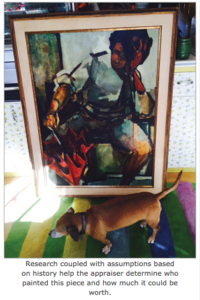 JS sent me a photograph of a large oil portrait of a man with a red umbrella. It’s signed, somewhat illegibly, DeGroot, DeGroat or DeGroote. Those spellings are within reason for such a Dutch name. Researching art not attributed to a known artist involves a series of assumptions.
JS sent me a photograph of a large oil portrait of a man with a red umbrella. It’s signed, somewhat illegibly, DeGroot, DeGroat or DeGroote. Those spellings are within reason for such a Dutch name. Researching art not attributed to a known artist involves a series of assumptions.
First, look at the painting, back and front. JS’s has a gallery label “The Lake Galleries, Carmel by the Sea.” On a scale of probabilities, DeGroot painted, at least a few times in his/her life, in California. For a gallery to represent an artist’s work, the gallery contracts a series. Work of this scale isn’t easily shipped across the country. Assumption #1: this is a California artist (with a very Dutch name). Does the gallery still operate? It’s not. In any event, is it likely the artist was of some significance. The gallery operated in the competitive art town, Carmel. Assumption #2: DeGroot was an artist of some repute for him to land a spot in a Carmel gallery.
Look at the style to assess the date of creation and date by analysis of DeGroot’s figure. Here’s where you need a little art history. What we notice might indicate a “school” or “movement.” We may be able to identify this artist by works of this style; once a style catches on in a certain region, a “school” develops. A style is contagious. The new “look” rebels against a previous school’s “look.”
What are the visual elements?
- Generous abstracted use of color.
- The modeling of a human figure.
- A style of outlining the figure in deep shadows or deep colors called ‘carving’.
- A close cropping of the figure to center-in on “mass.”
All these clues point to a certain school: The Bay Area Figurative Movement, a mid 20th century group of artists who rebelled against New York Abstract Expressionism (the previous popular “school”) returning to “figure” painting, 1950’s – 60’s. The “school” developed in formal schools with artists as professors: the San Francisco Art Institute, the California College of Arts and Crafts, and UC Berkeley.
Artists of this school include important painters such as David Park, known for his disdain for abstract art, his chromatic use of color, and his “carving” style of handling paint. Very descriptive of JS’s painting by De Groot, as well. Assumption #3: De Groot was a student of this “school.”
Other important teacher/artists in this movement 1950-60 were Elmer Bischoff and Richard Diebenkorn. In fact, Diebenkorn, Bischoff and Park held life-drawing sessions for artists, teaching their style of color and figuration. Leading us to confirm that this DeGroot was a California artist active 1950-60 in the Bay Area Figurative Movement.
Armed with the above three assumptions, lets do a search with three spellings of the artist’s name. The first initial of his first name could be a J. or G. Search until the profile of the artist based on your three assumptions meets a match with a similar name, then look closely at other works by the same artist.
I searched until I found a likely candidate, George Hugh DeGroat, born New Jersey 1917, died 1995 Carmel Valley, CA. An American artist active for some part of his life in Carmel. Did he teach or was he part of a school? He taught at Otis in Los Angeles, San Diego State and in Monterrey in adult education, a member of the American Association of University Professors. All at a time when educational institutions “taught” the leading “school,” California Figuration.
Now view DeGroat’s other works. Look for American Artists’ sales on AskArt.com. JS’s canvas is similar in color, mood, line, form, composition, and the human form to the canvases by him recorded as sold.
Now look for where DeGroat had shown to establish his “importance:” Pasadena and Santa Barbara Museums of Art, the Carmel, Los Angeles, Palos Verde Art Associations, and Otis. He became a Ford Foundation Fellow in 1969. Finally, he’s a “listed artist.” His name is listed in that very important book, Falk’s Who Was Who in American Art.
The value of JS’s painting? Auction records don’t include the sizes of the two works sold on AskArt’s site. I’d estimate $1,500 easily, most importantly because of the artist’s association with California Figuration. Mid-century art is HOT in the market today.